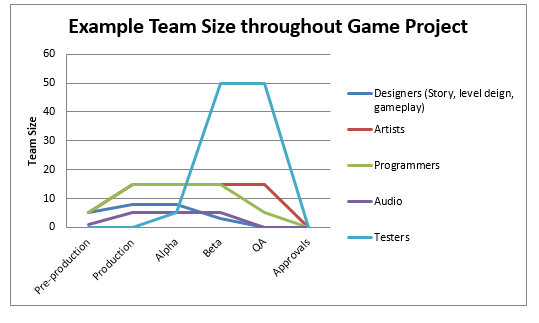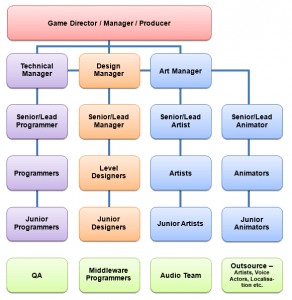The Pipeline for Making a Game – Who makes video games? What is the video game development process?
Video games are traditionally made by a whole team of people known as ‘developers’. Most developers have a specific skillset and knowledge that they bring to the games production such as programming, art or story-telling.
However with the modern games industry thriving on the internet, global connectivity and access to more and more tools and knowledge independent or ‘indie’ developers are breaking through in the industry. Games such as Flappy Bird are being created by one person and going on to make $20,000 per day, it’s proof that although the video game industry is becoming increasingly competitive it is still open to everyone and anyone who wants to get a job within it.

Game Studio – Who are game developers?
Traditional game development studios aren’t going anywhere any time soon though and if you’re interested in getting a job within the game industry then it is essential that you learn the video game development process and who it involves.
It is worth noting that the various roles at game studios do differ greatly. At one studio an animator may have a totally different set of tasks and duties to that of an animator at another studio. However there is a general rule of thumb for a standard video game development process.

Game Development Pipeline – How a game is made
Although the following is perhaps viewed from an artistic perspective it provides a general idea to the pipeline of a games creation:
First, it is DESIGNED. Designers, including writers are the ones who create the origin for a game that you will eventually see on a store shelf. The ideas for the story and the game are passed onto the concept artists.
Secondly, CONCEPTS are made. A concept artist’s job is to visually interpret the descriptions of the games world, ideas and characters from documents handed to them from the designers. Programmers will make early concept builds of the gameplay ideas.
Thirdly comes MODELLING – The modeller will then look at the art provided from the concepts and use that material to create 3D models or 2D models (depending on the games design). The art asset to be created could be the games character, vehicles or environment. 3D models are created using software such as Autodesk’s Maya or 3D Studio Max. The 3D artist will provide the art that will be used in the final game. However, before it does the work will be passed on for texturing.
TEXTURE ARTISTS – The texture artist’s role is to take the 3D/2D model and produce a texture for it. Textures are primarily created within 2D programs such as Adobe Photoshop. Once again, the model is then moved on to another specialist.
RIGGING – The next step in the video game development process is to rig the model. The rigger’s job is to make a model ready for animation. They do this by controlling the manipulable points of the 3D/2D model for animation. Rigging is often done by the animator themselves, or sometimes even a specialised modeller.
ANIMATION – The animator’s job is to bring the static model to life, similar to how a puppeteer uses strings to put life into a wooden doll. The work of an animation artist is often referred to as Computer Generated Imagery (CGI).
VISUAL EFFECTS ARTIST – The work is then passed onto the Visual Effects (VFX) artist, whose role is to spice things up. They will generally do this by adding custom effects such as smoke, sparks or the character’s footprints as they walk across the world. By adding this final polish the VFX artist really brings the 3D/2D object to a higher level of realism. This is the completion of the visual art side of the video game development process.
AUDIO ARTIST – Furthermore, an audio artist will then produce the sound effects that match the 3D/2D object functions. They are also responsible for creating ambient noises and the background music.
PROGRAMMER – It is time for a programmer to get their hands on it. Although the programmers are involved throughout the games production, for the development of a game asset, this is where they may typically get involved. The programmer creates code to activate events, triggers and animations of 3D/2D model. Once this is done, it is given to a level designer.
LEVEL DESIGN – With level design, the 3D/2D object is placed inside a game’s level. It is a level designer’s job to determine where to place objects to make it fun, fair and interesting for the game player.
QUALITY ASSURANCE (QA) – When working in the quality assurance department you will often be referred to as a QA tester. Under this title the QA tester is responsible for playing the game and hunting for bugs (unintentional errors found within the game). This information is then relayed back to the relevant department e.g. sound error will be reported to the audio team etc.
The majority of game development studios are made up of the kind of structure as described above although there can be further specialisation within the art, design and programming teams. Nowadays a lot of work is outsourced, particularly in 3D modelling, texturing and animation. This opens up the door to become a freelancer.
Game Developer Studios
Naughty Dog – Famous for Crash Bandicoot, Uncharted and The Last of US
Rockstar North – Creators of the Grand Theft Auto series
Polyphony Digital – Developers of racing game Gran Turismo
Epic Games – Makers of Gears of War
Electronic Arts – The people behind the FIFA franchise
Rovio Studios – The team behind Angry Birds
These are just a few of the thousands of developers world-wide. When going after a video game job it is important to find out who the developers are and contact them directly. It is also essential to show your knowledge of the video game development process to the studios in your interview.
Your Career
When starting off in the industry you will likely be presented with a junior role. It is a role that does hold limited responsibility and range but make the most of it as it does offer a gradual build up to your desired role and adds self-improvement and overall career progression.
For more information on how the game industry works, the game development pipeline and how to get into the video game industry take a look at our book: How to Become A Game Designer by Joshua Brown.
Image credits:
Audio artist: www.abc.net.au
Concept artist: www.reuters.com
Naughty Dog studio: levelsave.com